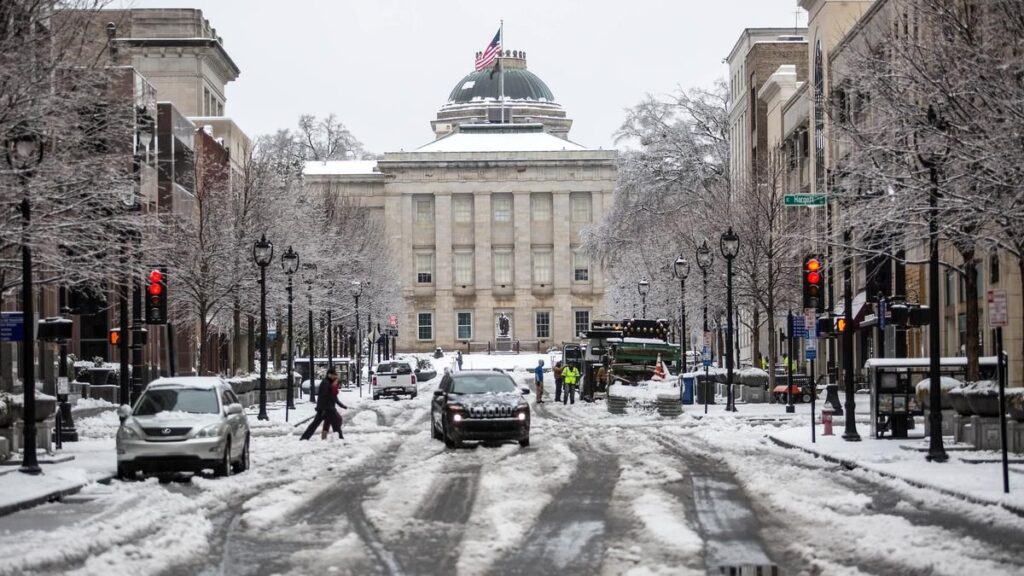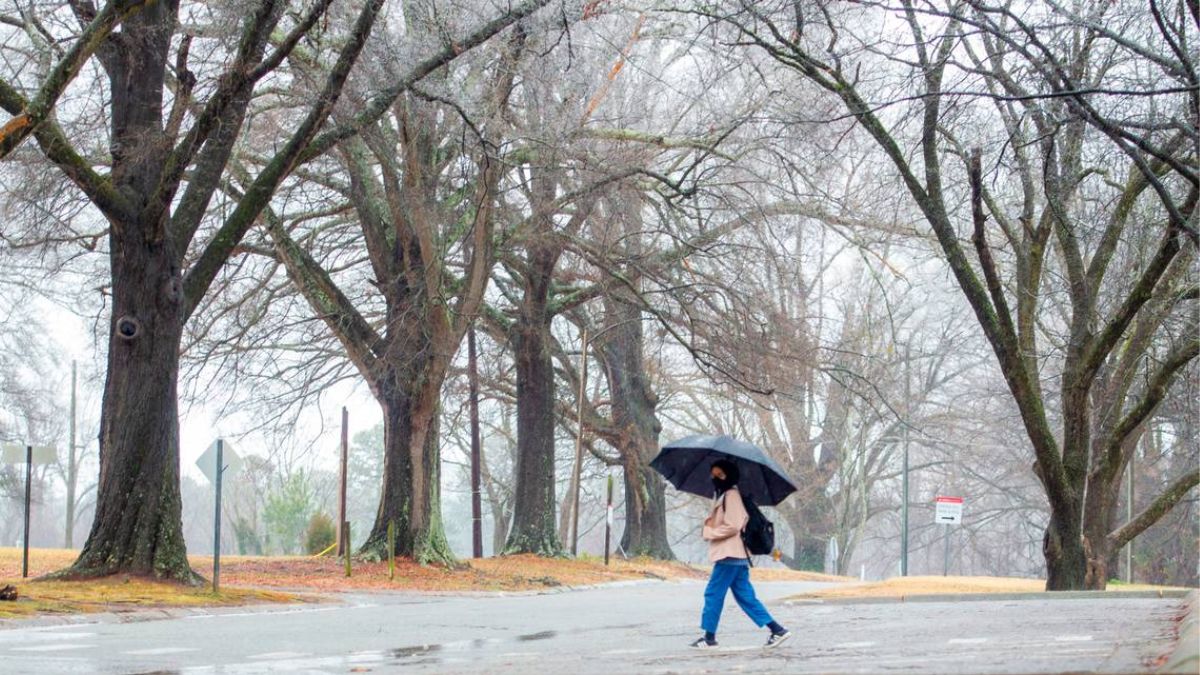Yes, it does snow in Raleigh, North Carolina, although the amount and frequency of snowfall are relatively low. On average, Raleigh receives about 6 inches of snow annually. Snowfall typically occurs during January and February.
When it comes to winter weather, one question often arises for those living in or planning to visit Raleigh, North Carolina: Does it snow in Raleigh?

With its moderate climate and southern location, the city may not be known for heavy snowfall like its northern counterparts, but it does experience winter weather. In this article, we’ll explore the snowfall patterns in Raleigh, NC, and what residents and visitors can expect during the winter months.
Location Overview
Raleigh is the capital city of the state of North Carolina in the United States. It is located in the central part of the state, in Wake County. Situated in the Piedmont region, Raleigh is part of the Research Triangle area, along with Durham and Chapel Hill.
The city is approximately 140 miles northeast of Charlotte and about 175 miles south of Richmond, Virginia. Raleigh is conveniently positioned within a few hours’ drive of the Atlantic coast to the east and the Appalachian Mountains to the west.
The city’s central location makes it easily accessible and serves as a hub for commerce, education, and culture in the region.
Geography and Climate of Raleigh
The geographical location of Raleigh, North Carolina, plays a significant role in its snowfall patterns. Situated in the central part of the state, Raleigh generally experiences milder winters compared to areas further north.
The city’s southern location and proximity to the Atlantic Ocean contribute to its relatively moderate climate. As a result, snowfall in Raleigh is less frequent and typically of lower accumulation compared to regions in the northeastern and midwestern parts of the United States.
The climate of Raleigh is characterized by a humid subtropical climate. This climate type typically features mild winters, hot summers, and ample precipitation throughout the year. While Raleigh experiences a wide range of weather conditions, snowfall is relatively infrequent.
Historical Snowfall Record
Raleigh has a historical record of snowfall that provides insights into the city’s past winter weather patterns. While the exact figures may vary from year to year, here is an overview of some notable snowfall events in Raleigh:
- March 2-3, 1927
Raleigh experienced its largest recorded snowstorm, with a total accumulation of 17.8 inches over a two-day period.
- February 12-13, 1899
Known as the “Great Arctic Outbreak” or the “Great Blizzard of 1899,” this event brought significant snowfall to Raleigh. The city received about 15 inches of snow.
- January 18-19, 2000
A winter storm brought approximately 13 inches of snow to Raleigh, causing widespread disruption in the area.
- December 25, 2010
Raleigh had a rare white Christmas with about 8 inches of snowfall, creating a festive atmosphere.
It is important to note that these are just a few examples, and snowfall amounts can vary significantly from year to year. While Raleigh does receive occasional snow, the average annual snowfall in the city is around 6 inches.
Winter Season & Snowfall Pattern
The amount of snowfall Raleigh receives is relatively modest compared to other parts of the United States, particularly those in the northeastern and midwestern regions. Snowfall in Raleigh tends to occur sporadically, and when it does, it often melts quickly due to the city’s milder winter temperatures.
Snowfall in Raleigh typically occurs during the winter months, January and February. However, the frequency and amount of snowfall can vary significantly from year to year. Some winters may see several snow events, while others may experience little to no snowfall at all.
Due to the relatively low occurrence of snow in Raleigh, the city is not as equipped to handle significant snow events compared to regions that regularly experience heavy snowfall. As a result, even a modest amount of snow can have a significant impact on daily life in the city.
Locations to Enjoy Snow
While Raleigh, North Carolina, may not be known for heavy snowfall, there are still a few locations in and around the city where you can enjoy the snowy experience. Here are some suggestions:
- Umstead State Park
Located just outside Raleigh, Umstead State Park offers scenic trails and beautiful wooded areas to explore during winter. When snow falls, the park transforms into a winter wonderland, providing opportunities for snowshoeing and cross-country skiing.
- Pullen Park
This historic park in Raleigh is a popular destination year-round, and during winter, it can be a delightful place to enjoy the snow. The park features open spaces, hills, and even a small lake. It’s an ideal spot for sledding, building snowmen, and having fun in the snow with family and friends.
- Lake Johnson Park
With its picturesque lake and surrounding trails, Lake Johnson Park offers a tranquil setting for winter activities. When snowfall occurs, the park becomes an inviting spot for winter walks. The scenic views and peaceful atmosphere make it an excellent location to embrace the beauty of snow.
- Triangle area ski resorts
While not in Raleigh itself, there are ski resorts within a few hours’ drive from the city. Resorts such as Appalachian Ski Mountain, Beech Mountain Resort, and Sugar Mountain Resort offer downhill skiing, snowboarding, and tubing experiences.
These mountain getaways provide a more traditional winter sports experience for those willing to travel a bit further.
While snowfall in Raleigh may be infrequent, when it does happen, these spots can offer enjoyable winter activities and a chance to make the most of the snowy season.
Factors Influencing Snowfall
Several factors influence snowfall patterns in Raleigh, North Carolina. The city’s geographical location plays a significant role, as Raleigh is situated in the Piedmont region and experiences milder winters compared to northern areas.
Its southern latitude and proximity to the Atlantic Ocean result in generally warmer temperatures, reducing the frequency and intensity of snowfall.
Additionally, the city’s elevation, which is relatively low compared to mountainous regions, contributes to less favorable conditions for significant snow accumulation. Atmospheric conditions, such as moisture availability and the interaction of weather systems, also impact snowfall amounts.
While snowfall can occur in Raleigh, these factors combine to make it less common and typically result in lighter snowfalls compared to regions further north.
Conclusion
While Raleigh, NC, may not be renowned for its snowy winters, it does receive a moderate amount of snowfall each year. The city’s mild climate and southern location contribute to the infrequent occurrence of snow, but when it does snow, it can impact daily life and provide opportunities for winter enjoyment.
So, while you may not need to invest in a heavy-duty snow shovel for Raleigh, be prepared for the occasional winter wonderland when the flakes start to fall.
